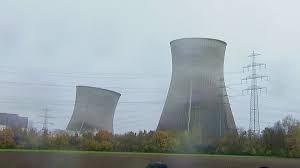"The workshop explores the enduring legacies of nuclear power as one of the defining technologies of the twentieth century. Between promises of technological progress and the persistence of risk, the workshop examines how the nuclear age continues to shape our present—through decommissioned sites, transformed landscapes, new research fields, and ongoing social movements. Discussions will address material infrastructures, ecological transformations, social and cultural afterlives, and the political and scientific controversies that have surrounded nuclear energy from its inception. The event aims to connect current research projects across Europe and beyond, foster collaboration, and lay the groundwork for a sustainable international network dedicated to the historical, social, and environmental dimensions of nuclear legacies."
Willkommen auf der Seite der "Textinitiative Fukushima"
Die Seiten der Textinitiative Fukushima werden derzeit von der Japanologie der Goethe-Universität betrieben. Gegenwärtiges Anliegen von TIF ist die zeitgeschichtliche Dokumentation. Das Forum dient nun in erster Linie als Archiv für Informationen zu 3/11 sowie allgemein zur Geschichte des Atomaren. Die Suchfunktion ermöglicht Recherchen zu Stichworten, Inhalten und Akteuren.
| KI und Kernenergie | 06.11.2025 |
"Das Kernenergie-Start-up von Ex-Microsoft-Chef Bill Gates, Terrapower, will zusammen mit einem der größten Betreiber von Rechenzentren in den USA, Sabey Data Centers (SDC), kleine Atomreaktoren (Small Nuclear Reactors) nutzen, um Rechenzentren zu betreiben." "Terrapower hat bereits im Juni 2024 mit dem Bau eines Mini-Kraftwerks als Pilotprojekt begonnen. Es entsteht in einem stillgelegten Kohlekraftwerk im US-Bundesstaat Wyoming nahe der Stadt Kemmerer." "Terrapower stellt sich als "grünes" Unternehmen dar, weil die Kernreaktoren keine Emissionen erzeugen wie etwa Kohlekraftwerke, die fossile Brennstoffe verwenden und damit CO₂ emittieren. Die kleinen Atomreaktoren sind jedoch genauso wenig umweltfreundlich wie größere Kernkraftwerke, denn die Entsorgung nuklearen Abfalls ist auch bei ihnen problematisch. SDC steht mit seinem Vorhaben jedoch nicht allein da. Amazon, Microsoft, Google und Meta wollen ebenfalls Atomkraft zur Energieerzeugung für ihre KI-Rechenzentren einsetzen." (Heise / 24. Januar 2025) |
|
| Tagung - Post-Atomic Formations: Dealing with the Legacies of Nuclear Power in Science, Society, and the Environment 20.-21 November 2025 | 02.11.2025 |
Programm Thursday, November 20, 2025 13:00 – Arrival 13:30–15:00 – Panel I: History of Technology and Science in Nuclear Energy 15:30–17:00 – Panel II: Nuclear Memory and Site Transformation 17:30–18:30 – Keynote Lecture Friday, November 21, 2025 9:30–11:15 - Panel III: Uranium Mining – Colonial Continuities and Global Entanglements 11:45–13:15 – Panel IV: Nuclear Environmental and Social Conflicts 14:00–14:30 – Final Discussion Kontakt
Registration and Information: forschungsinstitut@deutsches-museum.de |
|
| Kernenergieinnovation in China: Der Thorium-Flüssigsalzreaktor | 28.10.2025 |
"Kernenergie ist am Ende - jedenfalls in Deutschland. Auch in Westeuropa und Nordamerika werden nur noch in wenigen Ländern neue Reaktoren geplant. Im energiehungrigen Asien hingegen herrscht Aufbruchstimmung: Indien plant mehr als ein Dutzend neuer Kernkraftwerke und Choan über 40. In der Volksrepublik wird zudem eine Technologie erprobt, welche Kernenergie sicherer und günstiger machen soll. (...) In Chinas Wüste steht der weltweit wohl einzigartige Thorium-Flüssigsalzreaktor. Er wird mit dem leicht radioaktiven Metall Thorium "betankt". Thorium selbst ist zwar nicht spaltbar, kann aber im Reaktor unter Neutronenbeschuss zu spaltbarem Uran‑233 verwandelt werden. Der Vorteil daran: Thorium ist auf der Erde geschätzt dreimal häufiger als Uran. Die größten natürlichen Thorium-Vorkommen befinden sich in Indien, Brasilien, Australien und den USA. Aber auch China verfügt über den Rohstoff. Klingt nach einem großen Vorrat - doch es ist nicht trivial, Thorium als Kernbrennstoff zu nutzen. Reaktoren müssen so gebaut sein, dass Thorium konstant in frisches Uran-233 umgewandelt wird. Nach Experimenten mit verschiedenen Ansätzen in den vergangenen Jahrzehnten - unter anderem in den 1980er Jahren in Deutschland - hat sich einer als der wohl erfolgversprechendste herausgestellt: der Flüssigsalzreaktor." (ntv: Wissen, 26.Oktober 2025) Link: https://www.n-tv.de/wissen/China-macht-Fortschritte-bei-neuartiger-Kernenergie-article26006494.html |
|
| Vergrämung und Sprengwurst: Rückbau in der BRD - Die Kühltürme des 45 Jahre alten, 2021 geschlossenen AKW Gundremmingen sind Geschichte | 25.10.2025 |
"Die riesigen Kühltürme des ehemaligen Kernkraftwerks im schwäbischen Gundremmingen, in Günzburg, werden am Samstagmittag gesprengt. Gegen Mittag, um 12:00 Uhr werden die 160 Meter hohen Türme ein für alle Mal vom Stadtbild verschwinden." (BR/ARD 1) Links: https://www.ardmediathek.de/video/
|
|
| VORTRAG Steffi Richter: "Unsichtbares sichtbar machen. ‚The Maruki Gallery For The Hiroshima Panels'“ am 4. Dezember 2025 im Museum Fünf Kontinente / München | 20.10.2025 |
4. Dezember 2025: 18 Uhr Links: https://www.blog.japan.uni-muenchen.de/event/vortrag-von-prof-dr-steffi-richter |
|
|
6-10 von 810
|

 "Mit ihrer Eröffnung im Jahr 1967 unweit von Tokyo wurde die Maruki-Galerie Heimstatt für die als Genbaku no zu 『原爆の図』(Hiroshima Panels) bekannt gewordenen Wandbilder des Künstlerpaars Maruki (Maruki Iri/1901-1995 und Maruki Toshi/1912-2000). Die ersten sieben des insgesamt fünfzehn Gemälde umfassenden Zyklus, der zwischen 1950 und 1982 entstand, thematisieren unmittelbar die Opfer der über Hiroshima abgeworfenen Atombombe. Noch unter den Bedingungen der US-amerikanischen Besatzung und Zensur gingen die Künstler mit den Bildern zunächst in Japan selbst auf Wanderschaft, zeigten Millionen von Ausstellungsbesuchern erstmals das von den Bomben verursachte menschliche Leid. Auf ihren 1953 beginnenden Reisen in zahlreiche Länder der Welt wurden beide Künstler auch international wichtige Akteure der Friedens- und Anti-Atomkriegsbewegung. (...)"
"Mit ihrer Eröffnung im Jahr 1967 unweit von Tokyo wurde die Maruki-Galerie Heimstatt für die als Genbaku no zu 『原爆の図』(Hiroshima Panels) bekannt gewordenen Wandbilder des Künstlerpaars Maruki (Maruki Iri/1901-1995 und Maruki Toshi/1912-2000). Die ersten sieben des insgesamt fünfzehn Gemälde umfassenden Zyklus, der zwischen 1950 und 1982 entstand, thematisieren unmittelbar die Opfer der über Hiroshima abgeworfenen Atombombe. Noch unter den Bedingungen der US-amerikanischen Besatzung und Zensur gingen die Künstler mit den Bildern zunächst in Japan selbst auf Wanderschaft, zeigten Millionen von Ausstellungsbesuchern erstmals das von den Bomben verursachte menschliche Leid. Auf ihren 1953 beginnenden Reisen in zahlreiche Länder der Welt wurden beide Künstler auch international wichtige Akteure der Friedens- und Anti-Atomkriegsbewegung. (...)"